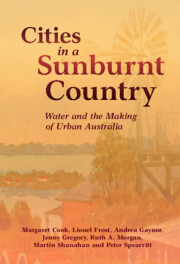Book contents
- Cities in a Sunburnt Country
- Studies in Environment and History
- Cities in a Sunburnt Country
- Copyright page
- Contents
- Figures
- Maps
- Book part
- Tables
- Acknowledgements
- 1 Prologue
- 2 Living Water
- 3 Domesticating Water
- 4 Keeping Up
- 5 Transforming Homes
- 6 Watering Suburbia
- 7 Crises of Confidence
- 8 Twenty-First Century Australian Cities
- 9 Epilogue
- References
- Index
- Studies in Environment and History
7 - Crises of Confidence
Published online by Cambridge University Press: 19 May 2022
- Cities in a Sunburnt Country
- Studies in Environment and History
- Cities in a Sunburnt Country
- Copyright page
- Contents
- Figures
- Maps
- Book part
- Tables
- Acknowledgements
- 1 Prologue
- 2 Living Water
- 3 Domesticating Water
- 4 Keeping Up
- 5 Transforming Homes
- 6 Watering Suburbia
- 7 Crises of Confidence
- 8 Twenty-First Century Australian Cities
- 9 Epilogue
- References
- Index
- Studies in Environment and History
Summary
In the wake of the ‘golden age’ of economic growth in the early 1970s, public provision of urban infrastructure came under the close scrutiny of governments seeking to reduce the size of their bureaucracies in the face of expanding budgets, rising prices, and increasing unemployment. Australian governments and water utilities followed the UK and USA by introducing price mechanisms to attain more efficient water use. This coincided with severe droughts that affected urban water supplies and led state governments to impose residential water restrictions, save for Brisbane, where catastrophic floods in 1974 reminded residents of their vulnerability to the elements. Growing concern for the environment, as well as the implications of environmental degradation for human health, meant that the sights, smells, and sounds of the Australian suburbs were on the eve of change. The use of suburban waterways as drains for industrial and domestic waste would no longer be tolerated, as local residents campaigned to protect built and natural environments from pollution and development projects. Such health and ecological concerns collided with the neoliberal reform agenda of the 1990s, when newly restructured water utilities faced a series of crises in their provision of water and disposal of wastes.
Keywords
- Type
- Chapter
- Information
- Cities in a Sunburnt CountryWater and the Making of Urban Australia, pp. 163 - 197Publisher: Cambridge University PressPrint publication year: 2022



